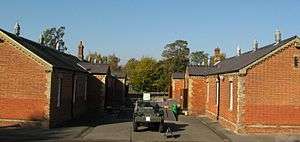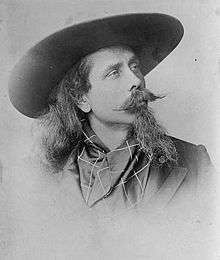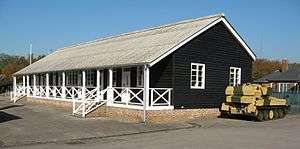Aldershot Military Museum

Aldershot Military Museum in Aldershot Military Town in Hampshire was conceived by former Aldershot Garrison Commander, the late Brigadier John Reed (1926-1992). Reed believed that it was essential to preserve the history of Aldershot Military Town and established the Aldershot Military Historical Trust to raise funds for the establishment of the Museum. Reed acquired the two Victorian barrack bungalows in which the Museum is still based.[1]
The Museum was opened by HRH The Duke of Gloucester in 1984 and is housed in the only two surviving barrack bungalows built in the "North Camp" area of Farnborough in the 1890s. The Museum tells the story of the British Army in Aldershot, the "Home of the British Army", from the Army's arrival in the area in the 1850s to the present day. It also acts as the local history Museum for the civil towns of Aldershot and Farnborough, which form the modern Borough of Rushmoor.
In 2014 ownership of the Aldershot Military Museum was transferred to the Hampshire Cultural Trust as part of a larger transfer of museums from Hampshire County Council and Winchester City Council [2]
Galleries

The Museum's military gallery tells the story of the Military Town of Aldershot, from 1854 to the present day. This includes the development of the early military camp, through to Aldershot Command and the current Aldershot Garrison. It was completely refurbished in 2001, thanks to a grant from the Heritage Lottery Fund. At this time the gallery was renamed The John Reed Gallery in memory of the Museum's founder.
The Montgomery Gallery building once stood in the grounds of Field Marshal Montgomery's home at Isington near Alton. It was built for him in 1947 to house his war time caravans and was moved to the museum in 1995 and houses some of the museum's collection of larger exhibits of field guns and other vehicles, including tanks.
The Rushmoor Local History Gallery tells the story of Aldershot and Farnborough, and the people and businesses associated with those towns. In this gallery are displays about George Potters, drum makers to the British Army, a Victorian shop, information on the French Imperial Family, the construction of Farnborough Abbey and the pottery industry of Farnborough and Cove.
In 1908, Farnborough was the site of Britain's first powered flight by the American, Samuel Franklin Cody. The Cody Gallery includes a reconstruction of part of Cody's Farnborough workshop and artifacts such as Cody's original flying helmet can be seen in this display.
The Boyce Building

Officially opened in November 2006, this 1930s wooden barrack block came from Queen Elizabeth Barracks, Church Crookham, and was once the home of the Regimental Administration Offices for the camp.
Carefully reconstructed[3] at the museum thanks to a £50,000 Heritage Lottery grant, the Boyce Gallery explores the users of the barracks which was once home to the Royal Army Service Corps, Royal Army Medical Corps, Royal Corps of Transport and many battalions from the Brigade of Gurkhas before closing in 2000.
References
- ↑ Biography of Brigadier John Reed on Hampshire County Council website
- ↑ "Hampshire and Winchester museums and art leased to trust". BBC News. 1 November 2014. Retrieved 2014-11-04.
- ↑ Wartime barracks saved and moved to Aldershot Military Museum 16 November 2006
External links
- Aldershot Military Museum - official site
- Aldershot Military Museum on the Ogilby Trust
- AboutBritain.com entry on Aldershot Military Museum
- Rushmoor Borough Council entry for Aldershot Military Museum
- Friends of Aldershot Military Museum
Coordinates: 51°16′11″N 0°45′02″W / 51.26963°N 0.75063°W